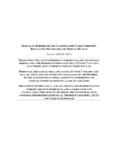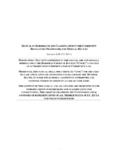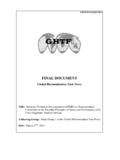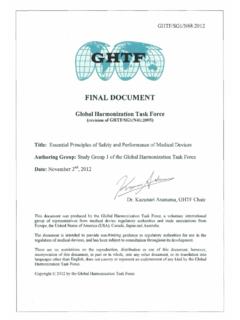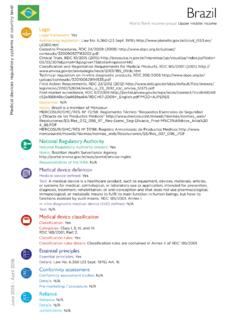Transcription of Classification Rules for Medical Devices
1 HtlaeH fo tnemtrapeDnoigeR evitartsinimdA laicepS gnoK gnoH eht fo tnemnrevoGanihC fo cilbupeR s elpoeP tnemtrapeD gnitnirP eht yb detnirP)repap delcycer no kni yldneirf yllatnemnorivne htiw detnirP( Technical Reference: TR-003 Date of Issue: 4 Jan. 2010ehTfoehtTechnical Reference: TR-003 Classification Rules for Medical Devices Table of Contents 1. Introduction .. 1 2. Scope .. 1 3. Definitions and Abbreviations .. 1 4. General Principles .. 1 5. Recommendations .. 2 6. The Determination of Device Class .. 5 7. Classification Rules for Medical Devices .. 5 8. Enquiries .. 12 9. References .. 12 - 1 - 1. Introduction This document is adapted from the GHTF document GHTF/SG1-N15:2006 for the principles of Medical Devices Classification in accordance with the requirements of the Medical Device Administrative Control System (MDACS).
2 The MDACS classifies Medical Devices other than in vitro diagnostic Medical device into four classes (Class I, II, III and IV) according to the Rules which are interpreted in Section 7 of this document. 2. Scope This document applies to all products that fall within the scope of the MDACS (please refer to the Guidance Notes GN-01: Overview of the Medical Device Administrative Control System). 3. Definitions and Abbreviations This booklet shall be read in conjunction with the Guidance Notes GN-00: Definitions and Abbreviations for the Medical Device Administrative Control System for the latest definitions and abbreviations of the terms used. 4.
3 General Principles Regulatory controls are intended to safeguard the health and safety of patients, users and other persons by ensuring that manufacturers of Medical Devices follow specified procedures during design, manufacture and marketing. Regulatory controls should be proportional to the level of risk associated with a Medical device. The level of regulatory control should increase with increasing degree of risk, taking account of the benefits offered by use of the device. At the same time, the imposition of regulatory controls should not place an unnecessary burden on regulators or manufacturers. Therefore, there is a need to classify Medical Devices based on their risk to patients, users and other persons.
4 The risk presented by a particular device depends substantially on its intended purpose and the effectiveness of the risk management techniques applied during design, manufacture and use. It also depends, in part, on its intended user(s), its mode of operation, and/or technologies. In general, the Classification Rules are intended to accommodate new technologies. - 2 - 5. Recommendations Primary Recommendation The manufacturer should document its justification for placing its product into a particular risk class, including the resolution of any matters of interpretation where it has asked a Conformity Assessment Body and/or MDCO for a ruling.
5 Factors Influencing Device Classification A number of factors, including for example the duration of device contact with the body, the degree of invasiveness, whether the device delivers medicinal products or energy to the patient, whether they are intended to have a biological effect on the patient and local versus systemic effects may, alone or in combination, affect device Classification . If, based on the manufacturer s intended purpose, two or more Classification Rules apply to the device, the device is allocated the highest level of Classification indicated. Where one Medical device is intended to be used together with another Medical device, that may or may not be from the same manufacturer, the Classification Rules should apply separately to each of the Devices .
6 Classification of an assemblage of Medical Devices that individually comply with all MDACS requirements depends on the manufacturer s purpose in packaging and marketing such a combination of separate Devices . For example: If the combination results in a product that is intended by the manufacturer to meet a purpose different from that of the individual Medical Devices that make it up, the combination is a new Medical device in its own right and should be classified according to the new intended use. If the combination is for the convenience of the user but does not change the intended uses of the individual Medical Devices that make it up, the Classification allocated to the assemblage for the purpose of a Declaration of Conformity is at the level of the highest classified device included within it.
7 If one or more of the Medical Devices that is in the assemblage has yet to comply with all the relevant regulatory requirements, the combination should be classified as a whole according to its intended use. - 3 - Accessories intended specifically by manufacturers to be used together with a parent Medical device to enable that Medical device to achieve its intended purpose, should be subject to all MDACS documents as apply to the Medical device itself. For Classification purposes an accessory may be classified as though it is a Medical device in its own right. While most software is incorporated into the Medical device itself, some is not.
8 Provided such standalone software falls within the scope of the definition for a Medical device , it should be classified as follows: Where it drives or influences the use of a separate Medical device, it should be classified according to the intended use of the combination. Where it is independent of any other Medical device, it is classified in its own right using the Rules in Section 7 of this document. Stand alone software (to the extent it falls within the definition of a Medical device) is deemed to be an active device. General Classification System for Medical Devices Figure 1 indicates the four risk classes of Devices .
9 The examples given are for illustration only and the manufacturer must apply the Classification Rules to each Medical device according to its intended purpose. Figure 1: General Classification system for Medical Devices CLASS RISK LEVEL DEVICE EXAMPLES I Low Risk Surgical retractors / tongue depressors II Low-moderate Risk Hypodermic Needles / suction equipment III Moderate-high Risk Lung ventilator / bone fixation plate IV High Risk Heart valves / implantable defibrillator Figure 2 shows a conceptual illustration of increasing levels of regulatory requirements as the device risk class increases. These regulatory controls may include, for example: technical data; product testing using in-house or independent resources; the need for and frequency of independent external audit of the manufacturer s quality system; and - 4 - independent external review of the manufacturer s technical data.
10 The concept is expanded in our Technical Reference TR-001 entitled Principles of Conformity Assessment for Medical Devices . - 5 - Figure 2: Conceptual illustration of regulatory controls increasing with device risk class 6. The Determination of Device Class The manufacturer should: 1. Decide if the product concerned is a Medical device, using the appropriate definition (See Section 3). NOTE: Medical Devices that are used for the in vitro examination of specimens derived from the human body are not covered by the Classification Rules within this document. 2. Document the intended use of the Medical device. 3. Take into consideration all the Rules that follow in order to establish the proper Classification for the device, noting that where a Medical device has features that place it into more than one class, Classification and conformity assessment should be based on the highest class indicated.


